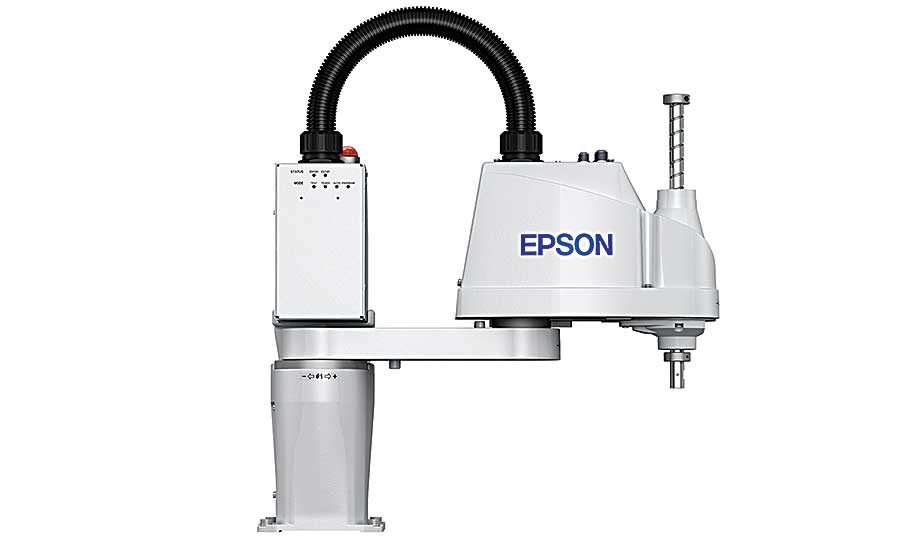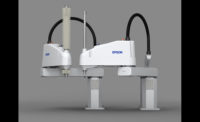Robot sales in North America hit record highs in 2017 in terms of both units sold and total sales. Manufacturers purchased 34,904 total units, representing $1.9 billion in total sales, according to the Robotic Industries Association (RIA).
Although the RIA does not provide a breakdown of robot sales by type, there’s little doubt that SCARA robots have been a major contributor to growth in the industry.
Robotics and automation are enabling more and more companies to reshore manufacturing jobs from China, says Chris Blanchette, national account manager for FANUC America Corp. “It has revitalized the small-parts assembly market in North America, so there’s been fairly significant growth in sales of SCARA robots in the Americas,” he says.
To meet that demand, robot suppliers have introduced several intriguing new SCARAs in the past year. Some have come from established leaders in the SCARA market, like Epson Robots and DENSO Robotics, while others have come from companies, like FANUC, that are more known for their six-axis robots. Here’s a look at the state of the art.
FANUC SR-3iA and SR-6iA
Last November, FANUC introduced the SR-3iA and SR-6iA SCARA robots at the International Robot Exhibition in Tokyo. The SR-3iA offers a 3-kilogram
payload, 400-millimeter reach and 200-millimeter stroke. The SR-6iA has a 6-kilogram payload, 650-millimeter reach and 210-millimeter stroke. With a 2-kilogram payload, the SR-3iA can perform a standard pick-and-place move—1 inch up, 12 inches across and 1 inch down—in just 0.33 second. The SR-6iA is even faster, at 0.29 second.
For FANUC, the SCARAs represent a significant new offering in the company’s established lineup of six-axis and delta robots.
“Years ago, we decided there wasn’t anything you could do with a SCARA that you couldn’t do with a six-axis robot, so we focused our efforts there,” admits Blanchette. “However, there were always a few applications where a six-axis robot couldn’t compete with a SCARA, particularly those requiring high speed and high precision at a reasonable price.”
Now, with the SR series, FANUC can compete for those applications, as well. But, says Blanchette, FANUC’s new SCARA is no mere “me-too” product. Indeed, the company spent more than a decade collecting “voice of the customer” data, assessing the failure points of current SCARAs, and developing features to make its SCARA stand out in a crowded field.
For example, the SR robot has a molded cable between the base of the robot and axis 2 for electrical power, servo control and compressed air. “Most of our competitors have a conduit assembly for routing those utilities,” says Blanchette. “Our customers told us that those conduits were one of the highest failure points in their robots. So we created a molded design that is very flexible and reliable.”
FANUC also addressed the reliability of the Z axis, or quill. “If a SCARA collides with something, the quill can bend, crack or snap off. Fixing it can be very costly,” explains Blanchette. “We evaluated all the quills in the industry and found nothing that met our reliability requirements, so we had a ballscrew manufacturer make something specifically
for us.”
FANUC’s quill is very sturdy and features a hollow center—14 millimeters in diameter—to allow passage of air and electrical lines.
The robot is also slim and compact, a key feature in small-parts assembly applications where space is at a premium. “Most SCARAs have a dead zone in back, but our robot has a 360-degree work envelope…and it can reach very close to its base,” says Blanchette. “In addition, we give you the option to have the power cable enter from the bottom of the robot, instead of the back. That frees up space behind the robot.”
Powered by the new R-30iB Compact Plus controller, the new SCARA robots offer the same intelligence and reliability available on all FANUC robots, including integrated vision, force sensing, conveyor tracking, fieldbus connectivity and integrated safety. The controller is also compact.
“It’s the smallest that FANUC has ever made,” says Blanchette. “It’s just 260 millimeters deep, 85 millimeters high and 440 millimeters wide. All the connectors plug into the front of the controller; you don’t need access to the back or sides.”
FANUC’s new SCARA iRProgrammer software interface is easy to use for programming with tablets or PCs, and can be accessed via a Web browser. “You can use a teach pendant to program the robot, but a teach pendant is not required,” says Blanchette. “You can program the robot by communicating with it through a standard HTML5 browser.”
The text-based editor has a menu of one-click instruction lists, which simplifies programming. Engineers also have the ability to position the robot by hand.
For more information, visit www.fanucamerica.com/SCARA. To see a video of FANUC’s new SCARA, click https://tinyurl.com/yaa54qze.
TM Robotics THE400
Also debuting at the International Robot Exhibition last fall was THE400 SCARA from TM Robotics. Combining high-speed operation and a high payload capacity, the new machine promises to deliver fast-cycle times for parts assembly, testing and transfer processes.
The robot is capable of operating speeds of 7,000 millimeters per second. With a 2-kilogram payload, the robot can complete a standard pick-and-place move in 0.3 second. The THE400 model can carry a maximum payload of 5 kilograms, with an allowable moment of inertia of 0.06 kilogram-square-meter.
To meet rising demand for fast-cycle automation, TM Robotics thoroughly redesigned the mechanism and control functions of previous SCARA robots to create the THE400. TM Robotics also improved the servo control of the robot, enabling enhanced arm-tracking performance and more accurate movement.
Optional specifications include an anti-dust design, a tool flange to attach a mounting hand, a bracket tailored to mount a vision camera, and a robot-controller cable that can be ordered in custom lengths.
In the future, TM Robotics plans to release clean-room and ceiling-mounted versions of the robot.
“Manufacturers are looking for robots with improved precision, faster speed and enhanced performance—and the THE400 delivers this,” explains Nigel Smith, managing director of TM Robotics.
For more information, visit http://tmrobotics.com/scara-the400/.
DENSO HSR
In September, DENSO Robotics introduced the HSR four-axis SCARA robot, which features advanced vibration control; a newly designed, highly rigid lightweight arm; and improved heat dissipation in the base unit.
“What sets the HSR apart is that it can run at its maximum speed and maintain its highest repeatability without interruption, not just in short bursts,” says Peter Cavallo, robotics sales manager for DENSO. “That translates into more cycles per minute, which in turn means higher throughput.”
Reduced shaft whip and settling time, along with a lighter-weight arm and an optimized arm structure, make the HSR more efficient than previous models, enabling it to accelerate faster, run continuously at its highest rated speed, and stop more precisely.
The standard cycle time (with a 2-kilogram payload) of the HSR robot is from 0.28 to 0.31 second. Repeatability is from ±0.01 to ±0.12 millimeter. Maximum payload capacity is 8 kilograms, and the robot is available with reaches of 480, 550 and 650
millimeters.
DENSO’s compact, space-saving design facilitates integration, while a high maximum moment of inertia allows a wide variety of end effectors and applications. Electrical wiring and air piping are internally embedded in the robot arm, preventing interference with peripherals. ANSI and CE compliance enables global deployment.
For more information, visit www.densorobotics.com/products/hsr-series.
Epson T3 All-in-One
Last September, Epson Robots launched the T3 all-in-one SCARA robot. Priced 30 to 50 percent less than conventional SCARAs, this compact robot is positioned to compete head-to-head with Cartesian robots.
“Our hypothesis was that the T3 could be used to replace linear slides in simple pick-and-place or material handling applications,” says Rick Brookshire, group product manager at Epson Robots. “What we’re finding is that our hypothesis was true and then some. The robot has been selling extremely well. It’s more flexible, more compact, and simpler to implement than linear slides.”
The T3’s controller is built into the robot’s base. There’s no need for a separate control cabinet or control box. There are no cables to run from the controller to the robot. A short cable duct on top of the robot also contributes to the overall compactness. The height difference lends itself to tight workcell enclosures.
With the controller built in, setup and deployment are faster and easier. To set up the T3, engineers simply mount the robot to a tabletop, attach the end-of-arm tool, and plug it in. After programming the robot through an intuitive user interface, the robot is ready for work.
An on-board I/O communications port adds to the all-in-one functionality. This provides a direct connection to the controller and includes power for the end-of-arm tooling, making it easier to connect cables to the end effector and supply power to it.
For applications requiring vision, the robot is already equipped to seamlessly integrate with an object-based, point-and-click interface for vision guidance. Using the integrated vision system allows all development to be done from one environment, thus reducing overall development and configuration time.
Most SCARA robots are equipped with battery-powered encoders. However, no battery is required for the T3’s encoder. That means engineers don’t have to halt the system to swap out batteries. Although this may be inconsequential with one robot, it’s a big advantage if several robots are working on an assembly line simultaneously.
In addition, the T3 consumes 30 percent less power than conventional SCARAs. Power consumption is less than a kilowatt, only 0.66 kilo-volt-ampere. The robot also plugs into a standard power receptacle and runs on 110 or 220 volts.
For more information, visit www.epsonrobots.com.







